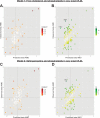Phenome-wide Mendelian randomisation analysis identifies causal factors for age-related macular degeneration
- PMID: 36705323
- PMCID: PMC9883012
- DOI: 10.7554/eLife.82546
Phenome-wide Mendelian randomisation analysis identifies causal factors for age-related macular degeneration
Abstract
Background: Age-related macular degeneration (AMD) is a leading cause of blindness in the industrialised world and is projected to affect >280 million people worldwide by 2040. Aiming to identify causal factors and potential therapeutic targets for this common condition, we designed and undertook a phenome-wide Mendelian randomisation (MR) study.
Methods: We evaluated the effect of 4591 exposure traits on early AMD using univariable MR. Statistically significant results were explored further using: validation in an advanced AMD cohort; MR Bayesian model averaging (MR-BMA); and multivariable MR.
Results: Overall, 44 traits were found to be putatively causal for early AMD in univariable analysis. Serum proteins that were found to have significant relationships with AMD included S100-A5 (odds ratio [OR] = 1.07, p-value = 6.80E-06), cathepsin F (OR = 1.10, p-value = 7.16E-05), and serine palmitoyltransferase 2 (OR = 0.86, p-value = 1.00E-03). Univariable MR analysis also supported roles for complement and immune cell traits. Although numerous lipid traits were found to be significantly related to AMD, MR-BMA suggested a driving causal role for serum sphingomyelin (marginal inclusion probability [MIP] = 0.76; model-averaged causal estimate [MACE] = 0.29).
Conclusions: The results of this MR study support several putative causal factors for AMD and highlight avenues for future translational research.
Funding: This project was funded by the Wellcome Trust (224643/Z/21/Z; 200990/Z/16/Z); the University of Manchester's Wellcome Institutional Strategic Support Fund (Wellcome ISSF) grant (204796/Z/16/Z); the UK National Institute for Health Research (NIHR) Academic Clinical Fellow and Clinical Lecturer Programmes; Retina UK and Fight for Sight (GR586); the Australian National Health and Medical Research Council (NHMRC) (1150144).
Keywords: AMD; Mendelian randomisation; Mendelian randomization; age-related macular degeneration; causal inference; human; macular degeneration; medicine; statistics.
© 2023, Julian et al.
Conflict of interest statement
TJ, JC, HG, ES, GB, PS No competing interests declared, SM Cofounder of Seonix Bio Ltd; holds stock in Seonix Bio Ltd, TA Involved in advisory boards and has received grants and speaker fees from Allergan, Novartis, Bayer, Roche, Bausch and Lomb, Heidelberg, Topcon and Canon; received consulting fees from Thea Pharmaceuticals
Figures



Similar articles
-
Cathepsins and age-related macular degeneration: A Mendelian randomization study unveiling causal relationships.Medicine (Baltimore). 2025 May 9;104(19):e42357. doi: 10.1097/MD.0000000000042357. Medicine (Baltimore). 2025. PMID: 40355192 Free PMC article.
-
The causal effects of lifestyle, circulating, pigment, and metabolic factors on early age-related macular degeneration: a comprehensive Mendelian randomization study.J Transl Med. 2024 Nov 1;22(1):988. doi: 10.1186/s12967-024-05773-9. J Transl Med. 2024. PMID: 39482668 Free PMC article.
-
Role of plasma fatty acid in age-related macular degeneration: insights from a mendelian randomization analysis.Lipids Health Dis. 2024 Jun 29;23(1):206. doi: 10.1186/s12944-024-02197-8. Lipids Health Dis. 2024. PMID: 38951820 Free PMC article.
-
Appraising the causal role of smoking in multiple diseases: A systematic review and meta-analysis of Mendelian randomization studies.EBioMedicine. 2022 Aug;82:104154. doi: 10.1016/j.ebiom.2022.104154. Epub 2022 Jul 8. EBioMedicine. 2022. PMID: 35816897 Free PMC article.
-
Health effects of high serum calcium levels: Updated phenome-wide Mendelian randomisation investigation and review of Mendelian randomisation studies.EBioMedicine. 2022 Feb;76:103865. doi: 10.1016/j.ebiom.2022.103865. Epub 2022 Feb 6. EBioMedicine. 2022. PMID: 35134646 Free PMC article.
Cited by
-
Causal roles of lipids and mediating proteins in diabetic retinopathy: insights from metabolomic and proteomic Mendelian randomization.Diabetol Metab Syndr. 2025 Apr 26;17(1):139. doi: 10.1186/s13098-025-01701-z. Diabetol Metab Syndr. 2025. PMID: 40287778 Free PMC article.
-
The role of coffee and potential mediators in subclinical atherosclerosis: insights from Mendelian randomization study.Front Nutr. 2024 Jul 25;11:1405353. doi: 10.3389/fnut.2024.1405353. eCollection 2024. Front Nutr. 2024. PMID: 39119461 Free PMC article.
-
Genetic associations between circulating immune cells and periodontitis highlight the prospect of systemic immunoregulation in periodontal care.Elife. 2024 Mar 27;12:RP92895. doi: 10.7554/eLife.92895. Elife. 2024. PMID: 38536078 Free PMC article.
-
Genetic evidence identifies a causal relationship between EBV infection and multiple myeloma risk.Sci Rep. 2025 Feb 21;15(1):6357. doi: 10.1038/s41598-025-90479-1. Sci Rep. 2025. PMID: 39984542 Free PMC article.
-
Exploring the relationship between cathepsin and age-related macular degeneration using Mendelian randomization.Front Med (Lausanne). 2024 Nov 6;11:1460779. doi: 10.3389/fmed.2024.1460779. eCollection 2024. Front Med (Lausanne). 2024. PMID: 39568745 Free PMC article.
References
-
- Benjamini Y, Hochberg Y. Controlling the false discovery rate: a practical and powerful approach to multiple testing. Journal of the Royal Statistical Society. 1995;57:289–300. doi: 10.1111/j.2517-6161.1995.tb02031.x. - DOI
-
- Boddy S, Islam M, Moll T, Kurz J, Burrows D, McGown A, Bhargava A, Julian TH, Harvey C, Marshall JNG, Hall BPC, Allen SP, Kenna KP, Sanderson E, Zhang S, Ramesh T, Snyder MP, Shaw PJ, McDermott C, Cooper-Knock J. Unbiased metabolome screen leads to personalized medicine strategy for amyotrophic lateral sclerosis. Brain Communications. 2022;4:fcac069. doi: 10.1093/braincomms/fcac069. - DOI - PMC - PubMed
Publication types
MeSH terms
Grants and funding
LinkOut - more resources
Full Text Sources
Medical

